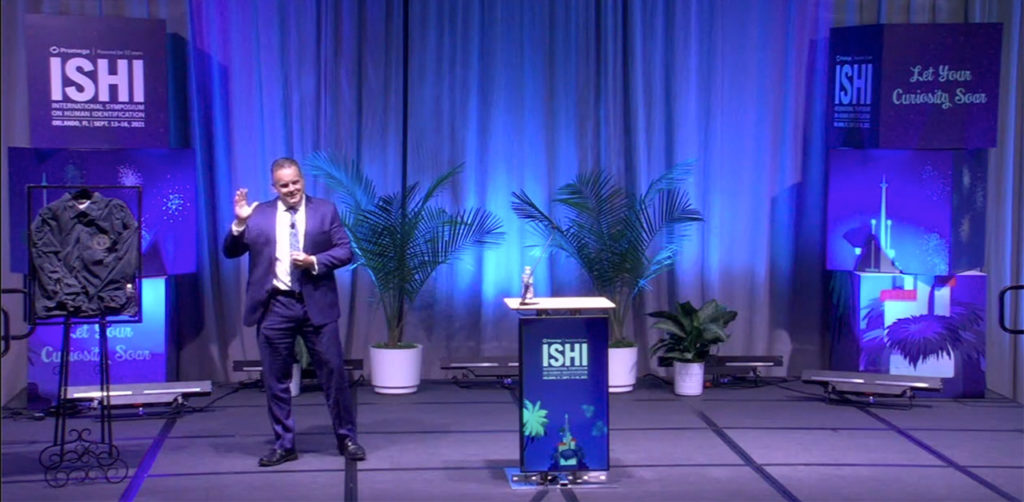The global COVID-19 pandemic has changed the entire conference and tradeshow industry. Although plans for many in-person conferences were paused, this month the 32nd International Symposium on Human Identification offered the best of both worlds: an in-person symposium in Orlando, Florida (September 12–16), and a virtual conference where registrants could view the session recordings online. At the symposium, exhibits and poster presentations offered attendees the opportunity to reconnect in person after long absences, while various networking events gave attendees a chance to catch up and socialize.

As usual, workshops were held before and after the main symposium. In a sign of the changing times, Rachel Oefelein and Tarah Nieroda (DNA Labs International) presented a talk on the unique challenges and opportunities associated with virtual courtroom testimony.
The weekend before the symposium was marked by an event of great significance across the world: the 20th anniversary of the September 11, 2001, terrorist attacks on the World Trade Center, the Pentagon, and the attempt on the U.S. Capitol that was thwarted by the brave sacrifice of the passengers and crew on board United Airlines Flight 93. In particular, the DNA forensics community was reminded of how much technology has evolved over the years, in the efforts—still ongoing—to identify the victims of the attacks.
Remembering 9/11
To commemorate the 9/11 anniversary, the New York City Office of Chief Medical Examiner (OCME) held a special video presentation, “Staying Strong: NYC OCME Reflects on 9/11”. It was only fitting that Mark Desire, Assistant Director of the OCME, deliver the first part of the keynote address at ISHI 32. He reflected on the OCME’s commitment to identifying the over 20,000 samples of human remains from the World Trade Center; to date, approximately 7,100 samples remain unidentified.
In his keynote address, Desire also shared the personal story of his close brush with death, when he was hit by debris from the South Tower. The memories of that day are still fresh in his mind, and he gave the audience a compelling account of the incredible efforts made by first responders in the hours and days following the collapse of the towers. He described how the forensics community came together with other agencies and scientists from around the world in a superhuman effort to identify those that perished in the attacks.

Mary Fetchet, Founding Director of the Voices Center for Resilience (VOICES), presented the second part of the keynote address. Her organization provides long-term support and resources that promote mental health care and wellness for victims’ families, responders, and survivors, while extending their efforts to assist communities in recovering from other tragedies. Like the OCME, VOICES remains committed to use their expertise beyond the work that began with 9/11.
The samples resulting from the 9/11 terrorist attacks proved to be the most challenging forensic samples ever processed, and this topic was explored further in a panel discussion chaired by Dr. Bruce Budowle (UNTHSC). Panelists included Mark Desire, Dr. Tim McMahon (AFDIL-AFMES) and Alan Giusti (FBI). The discussion also covered the FBI investigation to identify the hijackers and potential co-conspirators. Challenges to identification included working with extremely degraded and fragmented samples that often yielded no DNA suitable for analysis. Additionally, contamination and commingling of remains proved further obstacles to analysis. Logistical issues, lack of automation, and difficulty obtaining reference samples also complicated identification. Despite these challenges, the multidisciplinary, multiagency effort continues today, and new technologies—such as hybrid-capture sequencing recently validated at AFDIL—offer new hope for samples that were previously unidentifiable.
The application of mitochondrial DNA (mtDNA) sequencing, following improved extraction methods optimized for highly degraded ancient DNA samples, was the subject of another session presented by Elena Zavala (Max Planck Institute for Evolutionary Anthropology).
As in previous years, the general sessions covered a diverse range of topics, but common themes around popular technologies and policies emerged.
Rapid DNA
Rapid DNA technology has proven useful in the field for applications such as border security and public safety, prevention and detection of human trafficking, and identifications in mass casualty events. Dane Plaza (Bode Technology) described the operational challenges and the importance of a “reachback” support model to supplement efforts in the field, focusing on programs developed in partnership with the Department of Homeland Security. Dr. Douglas Hares (FBI) covered the use of rapid DNA technology by law enforcement, with a focus on its potential use at crime scenes in CODIS applications.
Forensic Genetic Genealogy (FGG)
Former FBI Special Agent Steve Busch (now CEO of FGG software company Indago Solutions) was instrumental in the FBI’s efforts for training their staff to work with local law enforcement in applying FGG. In his presentation, he addressed common myths about the use of FGG by law enforcement agencies. He also provided more details about the FBI efforts to advance the use of FGG and gave the audience a glimpse of what the future holds for this revolutionary method.
Leading the audience through a series of epiphanies from landmark cases, Dr. Colleen Fitzpatrick (Identifinders International) explored the deficits in the criminal justice system and CODIS that FGG has revealed. She also discussed the influence of public opinion on the use of FGG databases to solve crime.
Dr. Lawrence Wein (Stanford University) presented a two-stage mathematical model of the genealogy process, which is the most time-consuming part of FGG. The analysis allows for the prior assessment of the difficulty of a case, ultimately helping to decrease the case workload.
Using two examples, CeCe Moore (Parabon Nanolabs) demonstrated the use of FGG to solve two cold cases. The first led to the conviction of Michael DeVaughn in what was known as the Labor Day Murders. In this case, two women were viciously assaulted and murdered in Starkville, Mississippi, in 1990. The second case involved the identification of “Oscar Doe”, whose remains were found in a trash can at a construction site in Anne Arundel County, Maryland, in 1985. After conventional methods had failed, a combination of DNA phenotyping, kinship analysis, and FGG supported by social media research resulted in the identification of the unknown homicide victim as Roger Kelso of Glen Burnie, Maryland. Moore subsequently presented the case study on The Dr. Oz Show, hoping to gather more information that would lead to the identification of Kelso’s killer.
Massively Parallel Sequencing (MPS)
A decade has passed since Dr. Seth Faith introduced massively parallel sequencing (MPS) for STR typing at ISHI 22. While initial adoption of the technology was slow, it has seen increasing acceptance within the forensic community in recent years.
Dr. Jennifer Cihlar (UNTHSC) introduced a cross-platform MPS forensic workflow, using the PowerSeq® 46GY System, followed by library prep and sequencing on both the Verogen MiSeq® FGx System and the Ion Torrent Ion S5™ System. The data demonstrated good concordance across platforms and bioinformatics pipelines, while also pointing out potential methodology-based biases for the generated profiles.
Two presentations illustrated the use of MPS for analyzing ancestry information in widely divergent applications. Laurence DeVesse (King’s College London) showcased the results of genotyping 1,000 samples from five global population groups using the MiSeq FGx™ Forensic Genomics System. The analysis supplemented autosomal STR information with novel sequence variants that could be used for ancestry determination. Allison Sherier (UNTHSC) described the use of a custom targeted SNP panel for the human skin microbiome and identified ancestry-informative markers to identify the human host. The results showed that the microbiome could serve as a powerful alternative to traditional analysis, especially for samples with limited amounts of DNA. Sherier was an ISHI Student Ambassador last year and encourages her peers to check out the program.
Other Topics
Other technological innovations covered at ISHI 32 included DNA extraction from rootless hair (Dr. Ed Green, University of California—Santa Cruz), Y-STR analysis for missing persons cases (Dr. Jianye Ge, UNTHSC), an automated differential extraction method for sexual assault evidence samples (Emily Simek and Lies Janssens, Utah Bureau of Forensic Services), and proteomic analysis for human identification (Dr. Curt Hewitt, Signature Science). In addition, Sharon Bertsch McGrayne presented a fascinating history of the use of Bayes’ Rule in forensic investigations (also see the related article in The ISHI Report, February 2021.)
Several sessions covered policy topics of interest to the entire forensics community. Lisa Grossweiler (FBI) presented the customary CODIS and NDIS update. Dr. Tom Callaghan (FBI) discussed the latest information from the Investigative Genetic Genealogy Working Group, SWGDAM. Dr. John Butler (NIST) summarized the key findings and methodology used to prepare the draft NIST report on DNA mixture interpretation.
Next year, ISHI 33 will be held at the Gaylord National Harbor hotel near Washington, DC from October 31 through November 3. For more information, visit the ISHI News website.
Related Posts
Latest posts by Ken Doyle (see all)
- Will Artificial Intelligence (AI) Transform the Future of Life Science Research? - February 1, 2024
- RAF Inhibitors: Quantifying Drug-Target Occupancy at Active RAS-RAF Complexes in Live Cells - September 5, 2023
- Synthetic Biology: Minimal Cell, Maximal Opportunity - July 25, 2023
